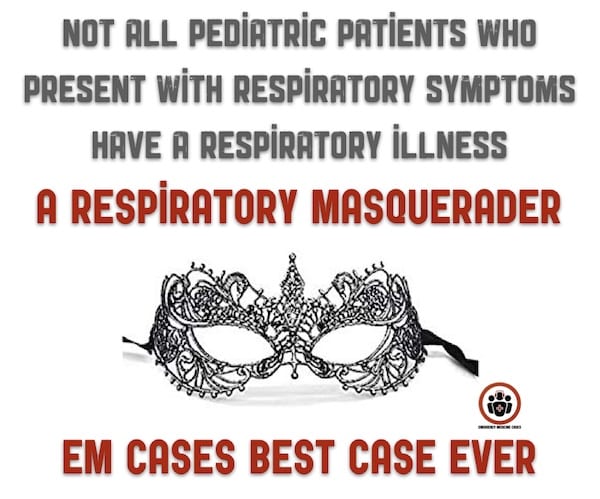In this EM Cases “Best Case Ever” podcast Rajiv interviews Dr. Eric Russell, Assistant Professor of Pediatrics at the Baylor College of Medicine, Pediatric Emergency Medicine attending physician at the Texas Children’s Hospital, and editor at the Human Diagnosis Project. They discuss a challenging case of a pediatric patient who presents with what at first appears to be bronchiolitis and respiratory failure…
Produced by Rajiv Thavanathan, Podcast editing by Richard Hoang,
Blog post written by Anton Helman, August, 2019
Pediatric myocarditis masquerading as respiratory failure
Pediatric myocarditis is a challenging ED diagnosis with about 2/3 being missed on initial presentation with about 1/3 presenting with respiratory symptoms that can easily be misdiagnosed as a respiratory illness with or without sepsis/septic shock. This is partly due to the non-specific and varied presentation from nonspecific viral symptoms to heart failure, cardiovascular collapse, and sudden death.
The most common presenting symptoms of pediatric myocarditis include dyspnea with feeding, vomiting, pallor, lethargy, and can even present with syncope or seizure. The majority present to the ED tachypneic, tachycardic and febrile sometimes with overt evidence of hypoperfusion on physical exam. A minority of patients present with cardiac features such as hepatomegaly, cardiac murmur.
One important clinical clue is tachycardia out of proportion to fever – heart rate increases by approximately 10 beats/min for every Celsius degree (1.8 degree of Fahrenheit) of fever >38°C.
Workup for pediatric myocarditis. CXR shows abnormalities in only about half of cases, usually signs of congestive heart failure, so a normal CXR should not be used to rule out myocarditis. One of the more useful immediate test is the ECG as almost all patients with myocarditis will have abnormal ECGs with the most common ECG findings besides tachycardia being nonspecific ST/T wave changes and low voltages. Aspartate aminotransferase is the most sensitive lab test with a sensitivity of 85% and Troponin is elevated in 85% of patients. While the most common misdiagnosis is respiratory tract infection, it is important to keep sepsis, severe dehydration and anemia in the differential diagnosis. POCUS may reveal global left ventricular or biventricular dysfunction, dilated cardiomyopathy, and reduced left ventricular ejection fraction (LVEF).
Initial management of the pediatric myocarditis patient includes rest, oxygen and diuretics. Early consultation with a pediatric cardiologist is advisable. Inotropic agents may be of benefit in moderate to severe heart failure, and ECMO may be required. For cardiac tamponade a pericardiocentesis should be performed as a first priority.
So when faced with a pediatric patient who presents febrile with respiratory symptoms, a viral prodrome and hypoperfusion, don’t assume bronchiolitis or pneumonia or sepsis; instead, consider congenital heart disease and myocarditis, scrutinize the CXR for signs of CHF, and obtain an ECG, which will almost always be abnormal in the pediatric patient with acute myocarditis.
The Human Diagnosis Project, where Dr. Russell is an editor, is funded by The MacArthur Foundation, The Gordon and Betty Moore Foundation, The Commonwealth Fund, Rx Foundation, Union Square Ventures, Andreessen Horowitz and Y Combinator.
References
- Recognition of respiratory distress and failure. In: Pediatric Advanced Life Support Provider Manual, Chameides L, Samson RA, Schexnayder SM, Hazinski MF (Eds), American Heart Association, Dallas 2011. p.37.
- Caforio AL, Pankuweit S, Arbustini E, et al. Current state of knowledge on aetiology, diagnosis, management, and therapy of myocarditis: a position statement of the European Society of Cardiology Working Group on Myocardial and Pericardial Diseases. Eur Heart J. 2013;34(33):2636-2648.
- Durani Y, Egan M, Baffa J, et al. Pediatric myocarditis: presenting clinical characteristics. Am J Emerg Med. 2009;27(8):942-947.
- Shu-ling C, Bautista D, Kit CC, Su-yin AA. Diagnostic evaluation of pediatric myocarditis in the emergency department: a 10-year case series in the Asian population. Pediatr Emerg Care. 2013;29(3):346-51.
- Dancea AB. Myocarditis in infants and children: A review for the paediatrician. Paediatr Child Health. 2001;6(8):543-5.
- Freedman SB, Haladyn JK, Floh A, Kirsh JA, Taylor G, Thull-freedman J. Pediatric myocarditis: emergency department clinical findings and diagnostic evaluation. Pediatrics. 2007;120(6):1278-85.
- Soongswang J, Durongpisitkul K, Nana A, et al. Cardiac troponin T: a marker in the diagnosis of acute myocarditis in children. Pediatr Cardiol. 2005;26(1):45-49.
- Doniger SJ. Bedside emergency cardiac ultrasound in children. J Emerg Trauma Shock. 2010;3(3):282-291.





Dear Anton, commending all the good works..Welldone